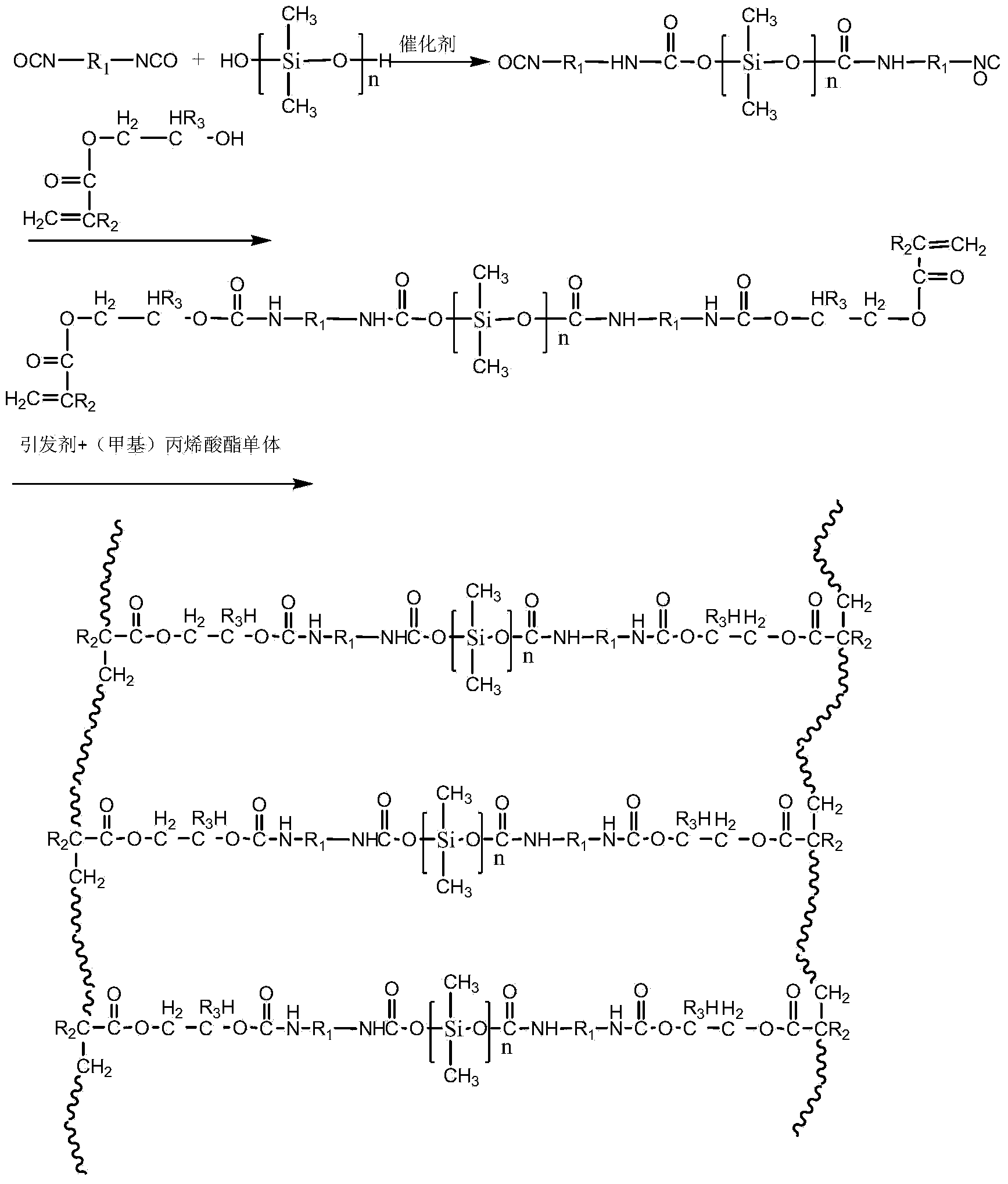Organic silicon modified water-based acrylate resin and preparation method thereof
A water-based acrylate and organosilicon technology, which is applied in the field of organosilicon-modified water-based acrylate resin and its preparation, can solve the problems of complex process, difficult gelation, expensive raw materials, etc., and achieves simple synthesis process and solvent resistance. Excellent, cheap and easy-to-obtain raw materials
- Summary
- Abstract
- Description
- Claims
- Application Information
AI Technical Summary
Problems solved by technology
Method used
Image
Examples
Embodiment 1
[0050] Embodiment one control NCO:OH is 2:1
[0051] (1) Add 40.29g (vacuum dehydration at 120°C for 2h) of hydroxyl silicone oil (average molecular weight is about 300), 0.1g of di-n-butyltin dilaurate and 59.71g of isophorone diisocyanate into a four-neck flask. The reaction was stirred at ℃ for 1-3 hours, and the NCO was tested every half an hour until the NCO content was 5.6wt%, and the reaction stopped.
[0052] (2) Lower the reaction temperature of step (1) to 60°C, add 17.48g of hydroxyethyl methacrylate and 0.14g of hydroquinone, react for 1-1.5h, take samples for infrared testing every half hour, until 2270cm -1 Absorption peaks appear everywhere, and the reaction stops.
[0053] (3) Lower the reaction temperature of step (2) to room temperature, add 145g methyl methacrylate, 6g methacrylic acid, 149g n-butyl acrylate, 600g deionized water, 8g sodium dodecylbenzenesulfonate and 4g Triton 100, stirred at a high speed until it was in the form of an emulsion to obtain ...
Embodiment 2
[0059] Embodiment two control NCO:OH is 2:1
[0060] (1) Add 40.29g (vacuum dehydration at 120°C for 2h) of hydroxyl silicone oil (average molecular weight is about 300), 0.1g of di-n-butyltin dilaurate and 59.71g of isophorone diisocyanate into a four-neck flask. The reaction was stirred at ℃ for 1-3 hours, and the NCO was tested every half an hour until the NCO content was 5.6wt%, and the reaction stopped.
[0061] (2) Lower the reaction temperature of step (1) to 60°C, add 17.48g of hydroxyethyl methacrylate and 0.14g of hydroquinone, react for 1-1.5h, take samples for infrared testing every half hour, until 2270cm -1 Absorption peaks appear everywhere, and the reaction stops.
[0062] (3) Lower the reaction temperature of step (2) to room temperature, add 200g methyl methacrylate, 6g methacrylic acid, 94g n-butyl acrylate, 600g deionized water, 8g sodium dodecylbenzenesulfonate and 4g Triton 100, stirred at a high speed until it was in the form of an emulsion to obtain a...
Embodiment 3
[0068] Embodiment 3 Control NCO:OH=1.2:1
[0069] (1) Add 52.93g (vacuum dehydration at 120°C for 2h) of hydroxyl silicone oil (average molecular weight is about 300), 0.1g of di-n-butyltin dilaurate and 47.07g of isophorone diisocyanate into a four-necked flask. Stir the reaction at ℃ for 1-3 hours, and test the NCO every half an hour until the NCO content is 5.6wt%, and the reaction stops.
[0070] (2) Reduce the reaction temperature of step (1) to 60°C, add 5.51g hydroxyethyl methacrylate and 0.07g hydroquinone, react for 1-1.5h, take samples for infrared testing every half hour, until 2270cm -1 Absorption peaks appear everywhere, and the reaction stops.
[0071] (3) Lower the reaction temperature of step (2) to room temperature, add 216g methyl methacrylate, 6g methacrylic acid, 78g n-butyl acrylate, 600g deionized water, 8g sodium dodecylbenzenesulfonate and 4g Triton 100, stirred at a high speed until it was in the form of an emulsion to obtain a pre-emulsion.
[0072...
PUM
 Login to View More
Login to View More Abstract
Description
Claims
Application Information
 Login to View More
Login to View More - R&D
- Intellectual Property
- Life Sciences
- Materials
- Tech Scout
- Unparalleled Data Quality
- Higher Quality Content
- 60% Fewer Hallucinations
Browse by: Latest US Patents, China's latest patents, Technical Efficacy Thesaurus, Application Domain, Technology Topic, Popular Technical Reports.
© 2025 PatSnap. All rights reserved.Legal|Privacy policy|Modern Slavery Act Transparency Statement|Sitemap|About US| Contact US: help@patsnap.com



